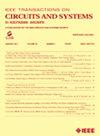基于增益峰值技术的43.4 db增益7.6 mw 197.5%带宽双降噪低温LNA多自旋量子位读出
IF 4.9
2区 工程技术
Q2 ENGINEERING, ELECTRICAL & ELECTRONIC
IEEE Transactions on Circuits and Systems II: Express Briefs
Pub Date : 2025-02-18
DOI:10.1109/TCSII.2025.3543474
引用次数: 0
摘要
摘要提出了一种基于低温堆叠逆变器的增益平坦化低噪声放大器(LNA),具有双电流复用和双噪声消除功能。LNA具有电流复用高q门电感和基于级联码逆变器的输入级,具有分流电阻反馈,可优化宽带输入阻抗。低温感知自我偏差(SBB)减轻了$V_{\ mathm {th}}$和$r_{\ mathm {out}}$在低温下的变化。该设计采用了一个源-退化共源(CS)主放大器,然后是电流复用电感增益峰值级联码双降噪CS晶体管,增强了主放大器和辅助放大器的跨导性并抑制了噪声。在低温(4 K)下,LNA的实测峰值增益$(S_{21})$为43.4 dB, 3-dB带宽为0.02 ~ 3.2 GHz(分数BW为197.5%),0.7 GHz时的最小NF为0.37 dB(对应噪声温度$T_{N}$为25.8 K),功耗为7.6 mW。电路的有效面积为0.31 mm2。本文章由计算机程序翻译,如有差异,请以英文原文为准。
A 43.4-dB Gain 7.6-mW 197.5% Bandwidth Double Noise-Canceling Cryogenic LNA Using Gain Peaking Technique for Multiple Spin Qubit Readout
This brief proposes a cryogenic stacked inverter-based gain-flattening low-noise amplifier (LNA) with dual current reuse and dual noise-canceling in 28-nm CMOS. The LNA features a current-reuse high-Q gate inductor and cascode inverter-based input stage with shunt-resistive feedback, optimizing wideband input impedance. A cryogenic aware self-body bias (SBB) mitigates $V_{\mathrm { th}}$ and $r_{\mathrm { out}}$ variations at cryogenic temperatures. The design incorporates a source-degenerated common-source (CS) main amplifier, followed by current reuse inductor gain peaking cascode dual noise-canceling CS transistors, enhancing transconductance and suppressing noise in both main and auxiliary amplifiers. At cryogenic temperature (4 K), the LNA achieves a measured peak gain $(S_{21})$ of 43.4 dB, with a large 3-dB bandwidth from 0.02 – 3.2 GHz (197.5% fractional BW) and a minimum NF of 0.37 dB (corresponding to noise temperature $T_{N}$ of 25.8 K) at 0.7 GHz under power dissipation of 7.6 mW. The circuit occupies an active area of 0.31 mm2.
求助全文
通过发布文献求助,成功后即可免费获取论文全文。
去求助
来源期刊
CiteScore
7.90
自引率
20.50%
发文量
883
审稿时长
3.0 months
期刊介绍:
TCAS II publishes brief papers in the field specified by the theory, analysis, design, and practical implementations of circuits, and the application of circuit techniques to systems and to signal processing. Included is the whole spectrum from basic scientific theory to industrial applications. The field of interest covered includes:
Circuits: Analog, Digital and Mixed Signal Circuits and Systems
Nonlinear Circuits and Systems, Integrated Sensors, MEMS and Systems on Chip, Nanoscale Circuits and Systems, Optoelectronic
Circuits and Systems, Power Electronics and Systems
Software for Analog-and-Logic Circuits and Systems
Control aspects of Circuits and Systems.

 求助内容:
求助内容: 应助结果提醒方式:
应助结果提醒方式:


